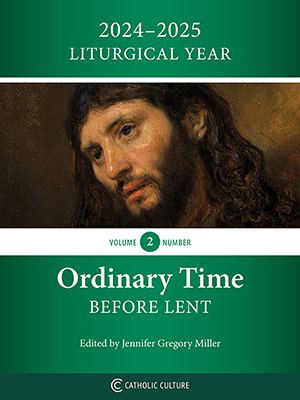Ordinary Time: October 1st
Memorial St. Therese of the Child Jesus, virgin and Doctor of the Church
Other Titles: The Little Flower; Theresa; Teresa; Thérèse of the Child Jesus and the Holy Face; Thérèse of the Infant Jesus; Theresa Lisieux; Thérèse Lisieux
» Enjoy our Liturgical Seasons series of e-books!
Today is the memorial of St. Thérèse of the Child Jesus and the Holy Face, more popularly known as "the Little Flower." Although just an obscure cloistered Carmelite nun, she has had universal appeal since her death in 1897. St. Thérèse is the patroness of all foreign missions and patroness of France. Her feast day was formerly October 3.
According to the 1962 Missal of St. John XXIII the Extraordinary Form of the Roman Rite, today is the feast of St. Remigius, bishop and confessor, who died in 533. He baptized King Clovis, bringing the Frankish nation to Christianity. He is one of the patrons of France.
St. Thérèse
 Marie Thérèse Martin was born at Alencon, France on January 2, 1873, the youngest of five daughters. Her father, Louis, was a watchmaker, and her mother, Zelie, who died of breast cancer when Thérèse was four, was a lace maker. She was brought up in a model Christian home. While still a child she felt the attraction of the cloister, and at fifteen obtained permission to enter the Carmel of Lisieux. For the next nine years she lived a very ordinary religious life. There are no miracles, exploits or austerities recorded of her. She attained a very high degree of holiness by carrying out her ordinary daily duties with perfect fidelity, having a childlike confidence in God's providence and merciful love and being ready to be at the service of others at all times. She also had a great love of the Church and a zeal for the conversion of souls. She prayed especially for priests. She died of consumption on September 30, 1897, at the age of 24, and was canonized in 1925. She has never ceased to fulfill her promise: "I will pass my heaven in doing good on earth." Her interior life is known through her autobiography called Story of a Soul. Pope Saint John Paul II declared her a Doctor of the Church in 1997.
Marie Thérèse Martin was born at Alencon, France on January 2, 1873, the youngest of five daughters. Her father, Louis, was a watchmaker, and her mother, Zelie, who died of breast cancer when Thérèse was four, was a lace maker. She was brought up in a model Christian home. While still a child she felt the attraction of the cloister, and at fifteen obtained permission to enter the Carmel of Lisieux. For the next nine years she lived a very ordinary religious life. There are no miracles, exploits or austerities recorded of her. She attained a very high degree of holiness by carrying out her ordinary daily duties with perfect fidelity, having a childlike confidence in God's providence and merciful love and being ready to be at the service of others at all times. She also had a great love of the Church and a zeal for the conversion of souls. She prayed especially for priests. She died of consumption on September 30, 1897, at the age of 24, and was canonized in 1925. She has never ceased to fulfill her promise: "I will pass my heaven in doing good on earth." Her interior life is known through her autobiography called Story of a Soul. Pope Saint John Paul II declared her a Doctor of the Church in 1997.
Patronage: florists; foreign missions; missionaries; pilots; against tuberculosis; AIDS sufferers; illness; loss of parents; Australia; France; Russia; Diocese of Fairbanks, Alaska; Diocese of Fresno, California; Diocese of Juneau, Alaska; Diocese of Pueblo, Colorado
Symbols and Representation: roses; discalced Carmelite nun holding roses; Carmelite nun with roses at her feet; Carmelite nun holding images of the Child Jesus and Holy Face of Jesus; Carmelite nun holding a crucifix and roses; book
Highlights and Things to Do:
- Find photographs of St. Thérèse and her family. Her sister Celine and cousin Marier Guerin had become interested in the art of photography, and when Celine entered the Carmelites with her sisters, she was given permission to bring her equipment and use it in the convent. A wonderful out-of-print book with all the photographs of this saint is called The Photo Album of St. Thérèse of Lisieux.
- Read St. Thérèse's autobiography The Story of a Soul: The Autobiography of St. Thérèse of Lisieux. The translation by John Clarke is considered the most accurate. Find biographies suitable for your children.
- The Institute of Carmelite Studies has a wonderful collection of writings by St. Thérèse and other books about her.
- Read more about her confidence in God, an excellent book is I Believe in Love: A Personal Retreat Based on the Teaching of St. Thérèse of Lisieux by Father Jean C. J. d'Elbee.
- St. Thérèse belonged to the Discalced order of Carmelites, which means unshod or barefoot. Find out more about the order of Carmelites.
- From the Catholic Culture Library:
- Pope Saint John Paul II from 1997, Divini Amoris Scientia (Apostolic Letter Proclaiming St. Thérèse of Lisieux a Doctor of the Church)
- Pope Saint John Paul II from 1997, Homily at Mass proclaiming Thérèse to be Doctor of the Church
- Apostolic Exhortation of Paul VI from 1975, On Christian Joy (Gaudete in Domino). He speaks of St. Thérèse:
In more recent times, St. Thérèse of Lisieux shows us the courageous way of abandonment into the hands of God to whom she entrusts her littleness. And yet it is not that she has no experience of the feeling of God's absence, a feeling which our century is harshly experiencing: "Sometimes it seems that the little bird (to which she compared herself) cannot believe that anything else exists except the clouds that envelop it.... This is the moment of perfect joy for the poor, weak little thing.... What happiness for it to remain there nevertheless, and to gaze at the invisible light that hides from its faith."
- Short Autobiography of St. Thérèse
- Thérèse of Lisieux — No Plaster Saint
- Saint Thérèse of Lisieux
- Learn about the Society of the Little Flower.
- There is the historic National Shrine of the Little Flower in Royal Oak, Michigan, a Basilica of the National Shrine of the Little Flower in San Antonio, Texas.
- Bake a cake or brownies and frost. Decorate with roses, either real, artificial, marzipan, icing, candy or other. Let your imagination go! See top bar for marzipan suggestions.
- Enjoy doing some rose crafts or recipes today. St. Thérèse's dying words were: "I will let fall a shower of roses after my death." Catholic Culture has some wonderful old-fashioned rose recipes.






